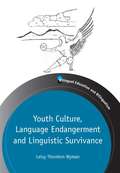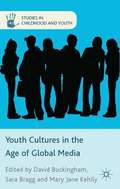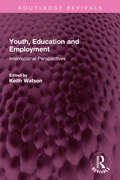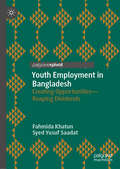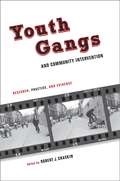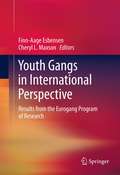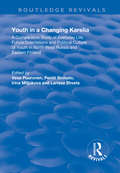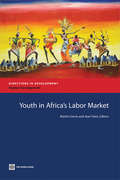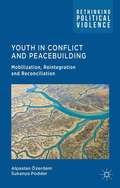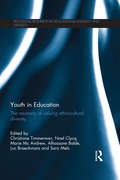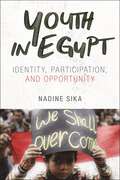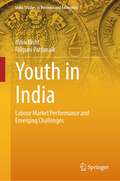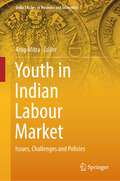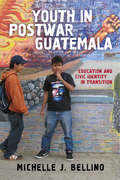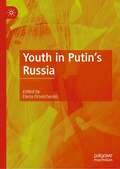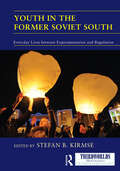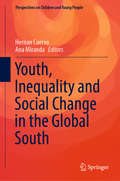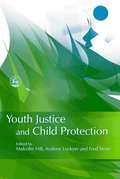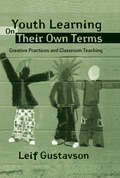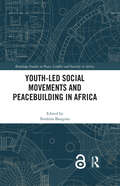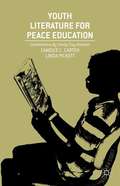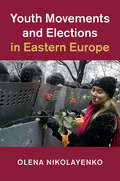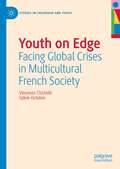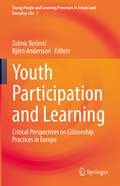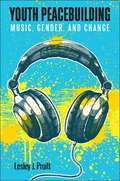- Table View
- List View
Youth Culture, Language Endangerment and Linguistic Survivance
by Leisy Thornton WymanDetailing a decade of life and language use in a remote Alaskan Yup'ik community, Youth Culture, Language Endangerment and Linguistic Survivance provides rare insight into young people's language brokering and Indigenous people's contemporary linguistic ecologies. This book examines how two consecutive groups of youth in a Yup'ik village negotiated eroding heritage language learning resources, changing language ideologies, and gendered subsistence practices while transforming community language use over time. Wyman shows how villagers used specific Yup'ik forms, genres, and discourse practices to foster learning in and out of school, underscoring the stakes of language endangerment. At the same time, by demonstrating how the youth and adults in the study used multiple languages, literacies and translanguaging to sustain a unique subarctic way of life, Wyman illuminates Indigenous peoples' wide-ranging forms of linguistic survivance in an interconnected world.
Youth Cultures in the Age of Global Media
by David Buckingham Sara Bragg Mary Jane KehilyThis book explores the impact of globalisation and new technologies on youth cultures around the world, from the Birmingham School to the youthscapes of South Korea. In a timely reappraisal of youth cultures in contemporary times, this collection profiles the best of new research in youth studies written by leading scholars in the field.
Youth, Education and Employment: International Perspectives (Routledge Revivals)
by Keith WatsonFirst published in 1983, Youth, Education and Employment tries to highlight the scale of the problem of youth unemployment in industrial societies by examining it from a variety of angles, and by drawing upon developments in other countries including those of the developing world. Examples are taken from France, Germany, Denmark and Sweden as well as from the United Kingdom, and also from Cuba and small island communities. This important volume shows the underlying causes of youth unemployment and offers positive solutions in particular stressing the need for a reappraisal of many educational practices. This book is a must read for educationists, policy makers and students of public policy.
Youth Employment in Bangladesh: Creating Opportunities—Reaping Dividends
by Fahmida Khatun Syed Yusuf SaadatThis book brings together pioneering and evidence-based research that focuses on youth employment—one of the foremost development challenges of our time—and fills a critical research and knowledge gap alongside consolidating existing relevant literature. Comprehensive in scope, the book provides an overview of trends in youth employment in Bangladesh, empirically analyses the determinants of youth unemployment, covers relevant economic theory, and recommends policy measures for employment creation in Bangladesh. The new evidence from Bangladesh on the aforesaid issues will inform relevant and concurrent policy discourse, add value to related research in the field, and inspire future research. The insights gathered through this study will serve as an important lesson for other developing countries on what works and what does not in policy-making.
Youth Gangs and Community Intervention: Research, Practice, and Evidence
by Chaskin Robert J. Ed.Although a range of program and policy responses to youth gangs exist, most are largely based on suppression, implemented by the police or other criminal justice agencies. Less attention and fewer resources have been directed to prevention and intervention strategies that draw on the participation of community organizations, schools, and social service agencies in the neighborhoods in which gangs operate. Also underemphasized is the importance of integrating such approaches at the local level. In this volume, leading researchers discuss effective intervention among youth gangs, focusing on the ideas behind, approaches to, and evidence about the effectiveness of community-based, youth gang interventions. Treating community as a crucial unit of analysis and action, these essays reorient our understanding of gangs and the measures undertaken to defeat them. They emphasize the importance of community, both as a context that shapes opportunity and as a resource that promotes positive youth engagement. Covering key themes and debates, this book explores the role of social capital and collective efficacy in informing youth gang intervention and evaluation, the importance of focusing on youth development within the context of community opportunities and pressures, and the possibilities of better linking research, policy, and practice when responding to youth gangs, among other critical issues.
Youth Gangs in International Perspective
by Cheryl L. Maxson Finn-Aage EsbensenAs a steady source of juvenile delinquents and an incubator for future adult offenders, the youth gang has long been a focus of attention, from their origins and prevalence to intervention and prevention strategies. But while delinquent youth form gangs worldwide, youth gang research has generally focused on the U.S. Youth Gangs in International Perspective provides a needed corrective by offering significant studies from across Europe, as well as Trinidad-Tobago and Israel. The book spans the diversity of the field in the cultural and scholarly traditions represented and methods used, analyzing not only the social processes under which gangs operate and cohere, but also the evolution of the research base, starting with the Eurogang Program's definition of the term youth gang. Cross-national and gender issues are discussed, as are measurement concerns and the possibility that the American conception of the youth gang is impeding European understanding of these groups. Among the topics covered: Gang dynamics through the lens of social identity theory.Defining gangs in youth correctional settings.Gang gender composition and youth delinquency.From Stockholm: a holistic approach to gang intervention.Gang membership as a turning point in the life course.The impact of globalization, immigration, and social process on neo-Nazi youth gangs. Filling a critical gap in the literature, Youth Gangs in International Perspective will find a wide audience among criminologists, policymakers specializing in youth crime, and researchers and graduate students in criminology, political science, and youth studies.
Youth in a Changing Karelia: A Comparative Study of Everyday Life, Future Orientations and Political Culture of Youth in North-West Russia and Eastern Finland
by Vesa Puuronen Pentti Sinisalo Larissa ShvetsThis title was first published in 2000: The book is aimed at uncovering certain features of the future of Karelia, which is partly situated in Russia and Finland. The authors believe that this can be done by studying in depth the opinions, values, norms, beliefs, fears and hopes of young people living in two neighbouring but profoundly different societies: Russia and Finland. Young people are constructing these societies in the 20th century. The book is based on a comparative research project, financed by the Academy of Finland, which was carried out during 1995-1997 by an international, inter-disciplinary research group. The novelty of the book is based on the use of different research methods and theoretical starting points. One of the crucial questions raised by the book concerns the applicability of Western theories in research into Russian society and people. The analysis shows that many of the concepts applied frequently in Western social sciences do not apply in research relating to Russian specific culture. The book proposes that more attention should be paid to the challenges of comparative research.
Youth in Africa's Labor Market
by Jean Fares Marito H. GarciaThe authors examine the challenges facing Africa's youth in their transition from school to working life, and propose a policy framework for meeting these challenges. Topics covered include the effect of education on employment and income, broadening employment opportunities, and enhancing youth capabilities.
Youth in Conflict and Peacebuilding
by Alpaslan Özerdem Sukanya PodderYouth in Conflict and Peacebuilding gives weight to the role of youth in peacebuilding, with specific reference to the processes of mobilisation, reintegration and reconciliation. #65533;zerdem and Podder reject the pejorative notion of youth as a security threat, a notion that still pervades the literature and practice of peacebuilding. The main objective of this study is, therefore, to provide a new conceptualisation of youth as a harbinger of peace, whether at an international or local level. By adopting a multi-disciplinary approach that identifies key themes in the analysis of its two main case studies of Liberia and Mindanao in the Philippines, this study maps out the debate surrounding the role of youth in post-conflict environments and draws from a wide range of cross-cultural examples. The failure to recognise youths as political actors can result in their contribution to peacebuilding being ignored, wasted and, at best, under-utilised. In recognising their agency as legitimate political actors, #65533;zerdem and Podder address the need for a comprehensive understanding of their valuable contribution to peacebuilding.
Youth in Education: The necessity of valuing ethnocultural diversity (Routledge Research in Educational Equality and Diversity)
by Christiane Timmerman, Noel Clycq, Marie Mc Andrew, Alhassane Balde, Luc Braeckmans and Sara MelsYouth in Education explores the multiple, interrelated social contexts that young people inhabit and navigate, and how educational institutions cope with increasing ethnic, cultural and ideological diversity. Schools, families and communities represent important settings in which young people must make successful transitions to adulthood, and the classroom often becomes a battleground in which these contexts and values interact. With contributions from the UK, Belgium, Germany and Canada, the chapters in this book explore rich examples from Europe and North America to suggest strategies that can help to counter negative perceptions, processes of stigmatization and disengagement, instead prioritising peer support and cooperative learning to give pupils a renewed sense of worth. This book takes the growing ethno-cultural diversity in education systems to heart and studies the various related educational processes from a multidisciplinary and multi-method approach. It aims to offer more insight into underlying mechanisms that are often implicit, but can be important factors that positively or negatively influence educational trajectories and outcomes. It is essential reading for researchers, academics and postgraduate students in the fields of education, sociology, higher education, policy and politics, and social and cultural geography.
Youth in Egypt: Identity, Participation, and Opportunity
by Nadine SikaAn eye-opening look at youth in contemporary Egypt, from the role they play in advancing political change to their everyday strugglesIn Youth in Egypt, Nadine Sika explores the political world of young people in Egypt, focusing on their experiences under authoritarianism. From the reigns of Gamal Abdel Nasser and Anwar Sadat to that of Abdel Fattah el-Sisi, she offers an on-the-ground perspective through the eyes of multiple generations of young people who lived through consecutive periods of political upheaval and state militarization.Drawing on surveys, interviews, and focus groups, Sika shines a light on youth who have participated in protest movements, civil society organizations, and political parties. She shows us the different opportunities for economic and political participation that exist for them, explaining why young Egyptians may choose to either mobilize against or—surprisingly—in support of the regime. Sika underscores how youth in Egypt have been regarded as both the “hope of the nation” and a “threat to the nation.” Youth in Egypt shines a light on the rising generation of young people that represents Egypt's future and also has significant implications for the broader Middle East and North Africa region.
Youth in India: Labour Market Performance and Emerging Challenges (India Studies in Business and Economics)
by Nitin Bisht Falguni PattanaikThis book provides an overview of youth labour force and workforce participation in India and explores the dynamics of changing youth labour market in India. Despite notifying a demographic dividend phase, a significant share of youth witnessed higher exclusion (unemployment and not in employment, education or training) from the Indian labour market. Therefore, this book investigates the role of education in labour market and examines open unemployment. It conceptualizes the not-in-employment-education-or-training (NEET) status of youth in Indian context and explores the heterogeneity of NEET youth by analysing the push and pull role of demographic and socio-economic variables. Furthermore, this book examines the nexus of youth labour market status and economic growth in India to provide plausible recommendations for youth's higher, inclusive and sustained participation in the labour market and the country's development pathway. The book creates room for necessary policy interventions considering the changing dynamics of youth labour market and contemplating the challenges of skill, technology and Industry 4.0., which entails a higher emphasis on ‘re-shape’, ‘re-focus’ and ‘re-share’ for enhanced and sustained inclusion of youth in labour market. It is a necessary resource for students, researchers, policymakers, and industry partners interested in exploring and understanding the political economy of youth labour market in India.
Youth in Indian Labour Market: Issues, Challenges and Policies (India Studies in Business and Economics)
by Arup MitraThis book addresses labour market participation issues of youth in India, and follows an inter-disciplinary approach. It carries out both quantitative and qualitative assessments for an in-depth understanding of these issues. It collates a wide range of concerns both from supply and demand side, and instead of reflecting on the empirical questions only, the book reflects on various analytical questions as well. Some other challenges being discussed here are inadequacy of skill and compulsion to participate in the labour market, concentration in activities with excess supplies of labour, unrecognised work experience, lack of upward mobility, and working with information asymmetry. Caste and gender disadvantages are an instrumental part of the book. Problems of educated and uneducated youth are quite different and the book analyses them separately. Besides, it refers to a wide range of issues relating to occupational flexibility. It also discusses skill imparting institutions and themajor lacuna associated with their functioning. Social unrest and threats to the prospects of future growth in the absence of adequate youth employment are some of the economic and political issues which the book covers. Unraveling the threads of the concerns mentioned above, the book finally comes up with policy suggestions. It is a great resource for researchers, industry watchers, and policy makers who are interested in inclusive and sustainable growth.
Youth in Postwar Guatemala: Education and Civic Identity in Transition
by Michelle J. BellinoIn the aftermath of armed conflict, how do new generations of young people learn about peace, justice, and democracy? Michelle J. Bellino describes how, following Guatemala’s civil war, adolescents at four schools in urban and rural communities learn about their country’s history of authoritarianism and develop civic identities within a fragile postwar democracy. Through rich ethnographic accounts, Youth in Postwar Guatemala, traces youth experiences in schools, homes, and communities, to examine how knowledge and attitudes toward historical injustice traverse public and private spaces, as well as generations. Bellino documents the ways that young people critically examine injustice while shaping an evolving sense of themselves as civic actors. In a country still marked by the legacies of war and division, young people navigate between the perilous work of critiquing the flawed democracy they inherited, and safely waiting for the one they were promised.
Youth in Putin's Russia
by Elena OmelchenkoThis edited volume sheds light on the lives of young people in various central and peripheral regions of Russia, including youth belonging to different ethnic and religious groups and who have differing views on contemporary politics. While the literature continues to grow regarding the inclusion of youth in global contexts, the specific cultural, political, and economic circumstances of being young in Russia make the Russian case unique. Chapter authors focus on four key aspects that characterize the youth experience in contemporary Russia: cultural practices and value affiliations, citizenship and patriotism, ethnic and religious diversity, and the labor market. This collection will appeal to readers interested in contemporary life in Russia and looking for the latest empirical material on youth identities and cultures, as well as those looking to learn about the critical viewpoint of local academics regarding the ongoing processes in contemporary Russian society.
Youth in the Former Soviet South: Everyday Lives between Experimentation and Regulation (ISSN)
by Stefan B. KirmseThis book offers the first comprehensive analysis of youth, in all its diversity, in Muslim Central Asia and the Caucasus. It brings together a range of academic perspectives, including media studies, Islamic studies, the sociology of youth, and social anthropology. While most discussions of youth in the former Soviet South frame the younger generation as victims of crisis, as targets of state policy, or as holy warriors, this book maps out the complexity and variance of everyday lives under post-Soviet conditions. Youth is not a clear-cut, predictable life stage. Yet, across the region, young people’s lives show forms of experimentation and regulation. Male and female youth explore new opportunities not only in the buzzing space of the city, but also in the more closely monitored neighbourhood of their family homes. At the same time, they are constrained by communal expectations, ethnic affiliation, urban or rural background and by gender and sexuality. While young people are more dependent and monitored than many others, they are also more eager to explore and challenge. In many ways, they stand at the cutting edge of globalization and post-Soviet change, and thus they offer innovative perspectives on these processes. This book was published as a special issue of Central Asian Survey.
Youth, Inequality and Social Change in the Global South (Perspectives on Children and Young People #6)
by Hernan Cuervo Ana MirandaThis book gathers international and interdisciplinary work on youth studies from the Global South, exploring issues such as continuity and change in youth transitions from education to work; contemporary debates on the impact of mobility, marginalization and violence on young lives; how digital technologies shape youth experiences; and how different institutions, cultures and structures generate a diversity of experiences of what it means to be young. The book is divided into four broad thematic sections: (a) Education, work and social structure; (b) Identity and belonging; (c) Place, mobilities and marginalization; and (d) Power, social conflict and new forms of political participation of youth.
Youth Justice and Child Protection
by Malcolm Hill Andrew Lockyer Fred StoneThis book is an examination of recent developments in the areas of youth justice and child protection. It investigates how well young people and the societies in which they live are served by judicial and service systems. Consideration is given to those in care - in young offenders' institutions, foster families and residential homes - as well as those living with their families. A broad range of international experts discuss the largely segregated youth justice and children's legal and service systems in England and Wales, other parts of Western Europe and the US, and compare these with Scotland's integrated system. The implications of these arrangements are considered for the rights of children and parents on the one hand and society on the other. The contributors also provide insights into the rationale for current and proposed policies, as well as the efficacy of different systems. This book will be an important reference for policy-makers, social workers, lawyers, magistrates and equivalent decision makers, health professionals, carers, and all those working in youth justice and child protection. It is highly relevant for academics and students interested in children, citizenship, youth crime, child welfare and state-family relations.
Youth Learning On Their Own Terms: Creative Practices and Classroom Teaching (Critical Youth Studies)
by Leif GustavsonYouth Learning On Their Own Terms convincingly shows how developing a respect and understanding of the youth-initiated creative practices that occur outside schools can offer educators the opportunity to directly influence their teaching in schools by making classroom spaces personally meaningful and rigorous for both students and teachers.
Youth-Led Social Movements and Peacebuilding in Africa (Routledge Studies in Peace, Conflict and Security in Africa)
by Ibrahim BanguraThis book critically examines and analyses the active role played by youth-led social movements in pushing for change and promoting peacebuilding in Africa, and their long-term impacts on society. Africa’s history is characterised by youth movements. The continent’s youth populations played pivotal roles in the campaign against colonialism and, ever since independence, Africa’s youth have been at the center of social mobilisation. Most recently, social media has contributed significantly to a further rise in youth-led social movements. However, the impact of youth voices is often marginalised by patriarchal and gerontocratic approaches to governance, denying them the place, voice, and recognition that they deserve. Drawing on empirical evidence from across the continent, this book analyses the drivers and long-term impacts of youth-led social movements on politics in African societies, especially in the area of peacebuilding. The book draws attention to the innovative ways in which young people continue to seek to re-engineer social space and challenge contexts that deny them their voice, place, recognition and identity. This book will be of interest to researchers across the fields of social movement studies, youth studies, peace and conflict studies, history, political sciences, social justice, and African studies.
Youth Literature for Peace Education
by Candice C. Carter Linda PickettCarter and Pickett explore how educators and families can teach peace education through youth literature and literacy development. Showing how to assess, choose, and make use of literature that can be used to teach both literacy and peace education, they walk through individual methods: recognizing and teaching different portrayals of conflict in youth literature, analyzing characterization, and examining the role of illustrations. Educators who want to incorporate peace education within a broader, literacy-focused curriculum, and peace educators looking for age-appropriate materials and methodologies will find Youth Literature for Peace Education a rich and interdisciplinary resource.
Youth Movements and Elections in Eastern Europe (Cambridge Studies in Contentious Politics)
by Olena NikolayenkoAt the turn of the twenty-first century, a tide of nonviolent youth movements swept across Eastern Europe. Young people demanded political change in repressive political regimes that emerged since the collapse of communism. The Serbian social movement Otpor (Resistance) played a vital role in bringing down Slobodan Milosevic in 2000. Inspired by Otpor's example, similar challenger organizations were formed in Azerbaijan, Belarus, Georgia, and Ukraine. The youth movements, however, differed in the extent to which they could mobilize citizens against the authoritarian governments on the eve of national elections. This book argues that the movement's tactics and state countermoves explain, in no small degree, divergent social movement outcomes. Using data from semi-structured interviews with former movement participants, public opinion polls, government publications, non-governmental organization (NGO) reports, and newspaper articles, the book traces state-movement interactions in five post-communist societies: Azerbaijan, Belarus, Georgia, Serbia, and Ukraine. Uses data from interviews with former movement participants, public opinion polls, government publications, non-governmental organization (NGO) reports, and newspaper articles. Provides a comparative analysis of state-movement interactions in five post-communist societies: Azerbaijan, Belarus, Georgia, Serbia, and Ukraine. Highlights a record of civic activism in the selected countries, and unravels the significance of learning from prior protest campaigns.
Youth on Edge: Facing Global Crises in Multicultural French Society (Studies in Childhood and Youth)
by Vincenzo Cicchelli Sylvie OctobreThis book explores disrupted youth cohesion in France within the context of multiple ongoing global economic, migratory, social, political, and security-related crises. While these trends can be observed in numerous Western societies, France provides a unique case study of various anti-cosmopolitan and anti-Enlightenment movements shaping youth conditions and reconfiguring relationships between the individual, the group, and society. The authors undertook in-depth interviews with French young people between the ages of 18 to 30 years old to inquire into how they experience "vivre ensemble" (living together) in a time of rising economic inequalities and multicultural tensions. Through these findings, they invite decision-makers, politicians, educators, and parents to propose a renewed narrative of social cohesion for youth who are not disillusioned, but deeply on edge.
Youth Participation and Learning: Critical Perspectives on Citizenship Practices in Europe (Young People and Learning Processes in School and Everyday Life #7)
by Zulmir Bečević Björn AnderssonThis book contributes to the studies on learning processes occurring outside “traditional” socialization settings such as family and school, by analysing civic and political participation and learning experiences. In this perspective, the book delves into the connections between the concepts of learning and participation and, in various ways and from different perspectives, critically interrogates learning and participation as interrelated phenomena, with the aim of revealing complexities implicated in pathways to adulthood. Being interdisciplinary in its nature (contributors come from disciplinary backgrounds such as educational sciences, child and youth studies, social work, sociology and political science), the volume provides an up-to date analysis of contemporary issues connected to youth participation and learning. The work taps into central areas of everyday life of young people and youth meaning-making and generates and presents qualitative knowledge about what it means to be young in Europe today.
Youth Peacebuilding: Music, Gender, and Change (SUNY series, Praxis: Theory in Action)
by Lesley J. PruittThis book highlights the important role youth can play in processes of peacebuilding by examining music as a tool for engaging youth in such activities. As Lesley J. Pruitt discusses throughout the book, music—as expression, as creation, as inspiration—can provide many unique insights into transforming conflicts, altering our understandings, and achieving change. She offers detailed empirical work on two youth peacebuilding programs in Australia and Northern Ireland, countries that appear overtly peaceful, but where youth still face structural violence and related direct violence at the community level. She also pays careful attention to the ways in which gender norms might influence young people's participation in music-based peacebuilding activities. Ultimately, the book defines a new research area linking youth cultures and music with peacebuilding practice and policy.
